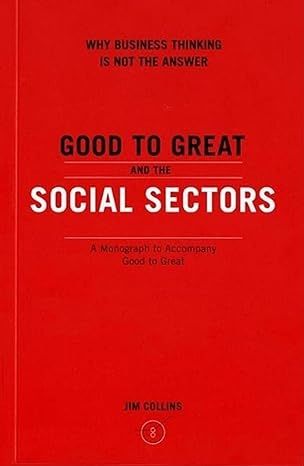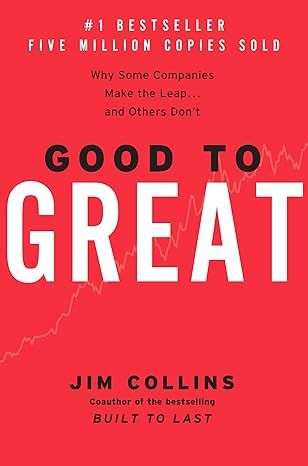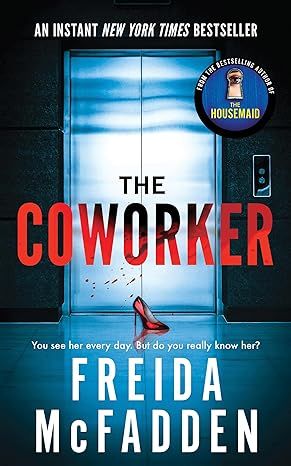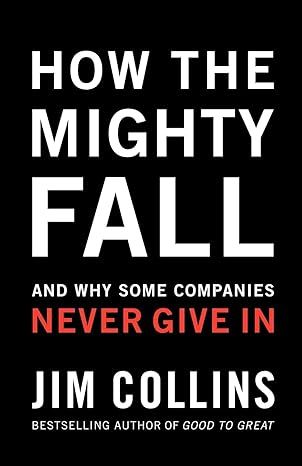How The Mighty Fall
4.6 out of 5
1,081 global ratings
Decline can be avoided. Decline can be detected. Decline can be reversed.
Amidst the desolate landscape of fallen great companies, Jim Collins began to wonder: How do the mighty fall? Can decline be detected early and avoided? How far can a company fall before the path toward doom becomes inevitable and unshakable? How can companies reverse course?
In How the Mighty Fall, Collins confronts these questions, offering leaders the well-founded hope that they can learn how to stave off decline and, if they find themselves falling, reverse their course. Collins' research project—more than four years in duration—uncovered five step-wise stages of decline:
Stage 1: Hubris Born of Success
Stage 2: Undisciplined Pursuit of More
Stage 3: Denial of Risk and Peril
Stage 4: Grasping for Salvation
Stage 5: Capitulation to Irrelevance or Death
By understanding these stages of decline, leaders can substantially reduce their chances of falling all the way to the bottom. Great companies can stumble, badly, and recover.
Every institution, no matter how great, is vulnerable to decline. There is no law of nature that the most powerful will inevitably remain at the top. Anyone can fall and most eventually do. But, as Collins' research emphasizes, some companies do indeed recover—in some cases, coming back even stronger—even after having crashed into the depths of Stage 4.
Decline, it turns out, is largely self-inflicted, and the path to recovery lies largely within our own hands. We are not imprisoned by our circumstances, our history, or even our staggering defeats along the way. As long as we never get entirely knocked out of the game, hope always remains. The mighty can fall, but they can often rise again.
244 pages,
Kindle
Audiobook
Hardcover
Paperback
Audio CD
First published May 18, 2009
ISBN 9780977326419
About the authors
Jim Collins
Jim Collins is a student and teacher of what makes great companies tick, and a Socratic advisor to leaders in the business and social sectors. Having invested more than a quarter century in rigorous research, he has authored or coauthored a series of books that have sold in total more than 10 million copies worldwide. They include Good to Great, the #1 bestseller, which examines why some companies make the leap and others don’t; the enduring classic Built to Last, which discovers why some companies remain visionary for generations; How the Mighty Fall, which delves into how once-great companies can self-destruct; and Great by Choice, which uncovers the leadership behaviors for thriving in chaos and uncertainty. Jim has also published two monographs that extend the ideas in his primary books: Good to Great and the Social Sectors and Turning the Flywheel.
His most recent publication is BE 2.0 (Beyond Entrepreneurship 2.0), an ambitious upgrade of his very first book; it returns Jim to his original focus on small, entrepreneurial companies and honors his coauthor and mentor Bill Lazier.
Driven by a relentless curiosity, Jim began his research and teaching career on the faculty at the Stanford Graduate School of Business, where he received the Distinguished Teaching Award in 1992. In 1995, he founded a management laboratory in Boulder, Colorado, where he conducts research and engages with CEOs and senior-leadership teams.
In addition to his work in the business sector, Jim has a passion for learning and teaching in the social sectors, including education, healthcare, government, faith-based organizations, social ventures, and cause-driven nonprofits. In 2012 and 2013, he had the honor to serve a two-year appointment as the Class of 1951 Chair for the Study of Leadership at the United States Military Academy at West Point.
Jim holds a bachelor's degree in mathematical sciences and an MBA from Stanford University, and honorary doctoral degrees from the University of Colorado and the Peter F. Drucker Graduate School of Management at Claremont Graduate University. In 2017, Forbes selected Jim as one of the 100 Greatest Living Business Minds.
Read more
Reviews
Thomas V. Morris
5
Well done
Reviewed in the United States on May 22, 2024
Verified Purchase
Collins always does a good job. I never agree on all things but his books are well researched and written.
Joshua Reich
5
Every leader should read this
Reviewed in the United States on May 20, 2011
Verified Purchase
On the plane ride back from Seattle the other day, I read Jim Collins latest book How the Mighty Fall. I've always been a huge fan of his work and this one is no different. While all his stuff is written for businesses, there are a ton of applications for churches.
In this book, Collins seeks to answer what leaders, companies and churches can learn from the failure of others. Is there a time that you can see a company is about to fail? Is there a path they all take? How do you know when a company/church full of energy, innovation and momentum, is there a time you know they are on the road to falling? Are there clearly distinguishable stages of decline? If so, can you spot the decline early? Are there telltale markers? Can you reverse decline, and if so, how? Is there a point of no return?
The reality is that according to Collins, "There are more ways to fall than to become great."
History shows that churches go through phases of this like companies do. The largest churches 50 years ago, many of them don't exist anymore or are no longer the largest, most effective churches. What happened? For many of those churches, the same as the companies that Collins talks about. They had no succession plan for leadership, they didn't develop leaders from within, and the big one, they became complex and got away from the thing they did best.
The best example in the book of this was the difference between Best Buy and Circuit City. Circuit City was once the standard in that industry, but they diversified and got away from their primary flywheel, the thing they did best. Churches have the tendency to do this as they grow. They add ministries, all good things, but it often takes away from the thing that is their primary flywheel, the thing God is blessing the most, the thing they have been called to do. Staying focused and simple is incredibly difficult. According to Collins, one of the telltale signs of a company that fell was not complacency, but stemmed more from overreaching.
What churches do is they are effective in something, so they add to it. They think success comes from doing things instead of asking the important question of "Do we know why we are successful, effective or healthy?" Churches are guilty of holding up practices and methods instead of the principles or theology behind what makes them effective. We have to do discipleship a certain way. The music has to be _________. We have to have this ministry or that program, even though it hasn't been effective in decades. What if instead of holding on to practices that aren't effective, we look at the principles to those practices, the Biblical practices churches are commanded to embody and live those out?
As Collins points out, "The best leaders know the why behind practices and effectiveness." They are always searching for the why, followed by the how. Yet, most pastors seek the how, followed by the why.
The last thing pastors can learn is have a sense of urgency. Companies that fell often lost their sense of urgency. I meet so many pastors, and church planters that do not have a sense of urgency. We, more than CEO's should have a sense of urgency. We are talking about the gospel, heaven and hell, eternity. This should keep us awake at night. Churches should be the most urgent organizations on the planet.
Overall, as with Collins other books, high marks. Every leader should read everything he writes.
For more reviews, see[...]
Read more
10 people found this helpful
John W. Pearson
5
On the Cusp of a Precipitous Fall
Reviewed in the United States on July 27, 2009
Verified Purchase
In the early pages of this cautionary, wake-up call, Jim Collins mentions what a mentor told him about effective teaching: "don't try to come up with the right answers; focus on asking good questions." I started to count the elbow-in-the-ribs questions, but I ran out of ribs.
Some best-selling authors are one-book wonders. Not Collins. The author of Built to Last and Good to Great has delivered another barn-burner. While it builds on all of his previous work--like a good business book should--it aptly kick-starts you in the gut with not just good questions, but extraordinary insights. These are the "I-better-listen-carefully-and-not-mess-up" kind of soul-stirring questions timed perfectly for today's economic environment.
He writes, "I've come to see institutional decline like a staged disease: harder to detect but easier to cure in the early stages, easier to detect but harder to cure in the later stages. An institution can look strong on the outside but already be sick on the inside, dangerously on the cusp of a precipitous fall."
It's not a happy book--it's a must-read book. Leaders that are in it for the long haul will learn principles and best practices for preventing, detecting and reversing decline. Collins identifies five stages of decline:
- Stage 1: Hubris Born of Success
- Stage 2: Undisciplined Pursuit of More
- Stage 3: Denial of Risk and Peril
- Stage 4: Grasping for Salvation
- Stage 5: Capitulation to Irrelevance or Death
"Overreaching" is one of the symptoms of Stage 2. "When an organization grows beyond its ability to fill its key seats with the right people, it has set itself up for a fall," he warns.
So why study failures? "We do ourselves a disservice by studying only success." Collins adds that "most companies eventually fall, and we cannot deny this fact." If you're leading a company, nonprofit or church today, it's possible that your own arrogance is blocking your view of reality, but there is hope. "Organizational decline is largely self-inflicted, and recovery largely within our control."
Read more
3 people found this helpful
Kathy Askew
5
GREAT BOOK!
Reviewed in the United States on September 12, 2024
Verified Purchase
This is a great book and was very informative.

Theodore A. Rushton
5
Brilliant! A long last some basic common sense
Reviewed in the United States on December 20, 2009
Verified Purchase
Brilliant.
It's the only way to describe a book that reasserts the obvious, the basics, the human fundamentals that have not changed in at least 5,000 years. Hubris. Arrogance. Greed. Bureaucracy. The Greeks examined these topics 2,500 years ago. William Shakespeare asserted human faults lies in ourselves and not in our stars. But who listens to such common sense?
Collins is criticized by those who cite "external" factors affecting the economy instead of their own failings. Well, one fact must be accepted: Every economy is people based. People create the economy, people run it and people are its glories and faults. If it doesn't satisfy the needs of people, even the cleverest "economy" is nothing. Economists who claim to have a formula to explain the economic future are the alchemists of the modern world; the future is what people do, and that is never predictable.
"Whether you prevail or fail, endure or die, depends more on what you do to yourself than on what the world does to you," Collins writes. This infuriates conservatives because it implies they or America aren't destined by God to be No. 1. Liberals hate it because it tells them they cannot devise a formula to make everyone healthy, wealthy, wise and happy Democratic voters.
"We are doing God's work," said Lloyd Blankfein, chief executive of Goldman Sachs. God was not pleased, so Goldman Sachs got its $10 billion bailout from taxpayers. Even the Son of God didn't think money changers are that good or well connected; He tossed them out of the temple.
The fact Collins stresses most is customer service. He cites various cases of companies ignoring this rule and subsequently failing. Motorola is an example; my trying to trying to deal helpfully with Motorola was an exercise in futility. Motorola thought customers existed to make Motorola rich. Collins deftly points out how this led to Motorla's collapse.
Business people who fail to heed this book will fail; those who do understand it may have a lot more to learn, but at least they understand the basics. Buy a copy for your favourite chief executive, and give it with the reminder: There Will Be a Test With One Answer.
The only answer that matters is the success or failure of the business.
Read more
Chris MacAskill
5
Only the paranoid survive
Reviewed in the United States on May 20, 2009
Verified Purchase
I have no connection to Jim Collins or the publisher, but if Amazon would let me give his previous book,
16 people found this helpful

Dave Kinnear
5
Hubris before the fall . . .
Reviewed in the United States on June 6, 2010
Verified Purchase
The silent creep of impending doom is the title Collins chose for the first chapter in this excellent review of how companies go astray. As usual, Collins did an in depth research to discover why companies fail and how that failure is shaped. He determined that there are five stages of decline for an organization:
- Stage 1 is characterized by hubris born of success
- Stage 2 is marked by undisciplined pursuit of more
- Stage 3 is the peak of ascendancy and characterized by denial of risk and peril
- Stage 4 begins the precipitous decline with the organization grasping for salvation
- Stage 5 is the final capitulation to being irrelevant or accepting death
Collins points out that a company does not have to go through all stages of decline, they can determine when they are in decline and can turn things around with some effort and attention. He also points out that not all companies deserve to survive; it's good that some fail. To make his case on the stages of decline and the results, Collins has provided many examples from companies we might know.
What stands out most in this book is how we can see that in our very success lie the seeds of our own demise. It makes Andy Grove's view of "only the paranoid survive" one that makes sense. If we are always concerned and afraid that we won't make it to the next year and that competitors are about to best us and customers abandon us then we are not too likely to become victims of hubris and excess. We can learn from that attitude.
As an example of Stage 1, Collins recounts the track Motorola is on from about 1983 through the 1990's explaining that their success in growing the company from $5 Billion to $27 Billion lead to arrogance and neglect. He also traced Circuit City's demise and drives home the point that our very success leads us to be blind to the things going on around us. This is true of individuals and organizations of all makes, models and sizes!
Collins provides the following as "markers" for Stage 1:
- Success entitlement, arrogance
- Neglect of a primary flywheel
- "What" replaces "Why"
- Decline in learning orientation
- Discounting the role of luck
In the chapter on Stage 2, Collins discusses Ames and its undisciplined pursuit of growth starting with the acquisition of Zayers. Here he makes the distinction between overreaching and complacency. Collins points out that of the cases he studied only one had a clear cut case of complacency and that was A&P in retail. Because the acquisition of Zayers, Ames destroyed the momentum it had built up over a decade. Meanwhile, WallMart was minding its "p's and q's," relentlessly building its stores across the country. One followed their plan and was content to manage growth, the other was intent on growth for the sake of growth and overreached to the point of failure.
Collins provides the following as "markers" for Stage 2:
- Unsustainable Quest for Growth, confusing big with great
- Undisciplined discontinuous leaps
- Declining proportion of right people in key seats
- Easy cash erodes cost discipline
- Bureaucracy subverts discipline
- Problematic succession of power
- Personal interests placed above the organizational interests
Motorola makes another appearance in Stage 3. This time it is for making big bets in the face of mounting evidence that you're going in the wrong direction. But Motorola was intent on establishing satellite telephone (recall Iridium?) and disregarded all the signs that they were attacking a market that didn't exist - full on denial of risk and peril. Collins warns "audacious goal stimulate progress, but big bets without empirical validation, or that fly in the face of mounting evidence, can bring companies down, unless they're blessed with unusual luck. And luck is not a reliable strategy."
In addition, Collins reviewed the issue with Challenger. "Can you prove that it's safe to launch?" was the traditional guide for a launch decision. However, the frame had inverted to "Can you prove that it's unsafe to launch." If NASA had not made that frame shift, or if the data had been absolutely definitive, Challenger very likely would have remained on the launch pad until later in the day.
Collins provides the following as "markers" for Stage 3:
- Amplify the positive, discount the negative
- Big bets and bold goals without empirical validation
- Incurring huge downside risk based on ambiguous data
- Erosion of healthy team dynamics
- Externalizing blame
- Obsessive reorganization
- Imperious detachment
After a successful run from 1992 through 1998, HP's CEO Lew Platt found himself being described as "struggling, perhaps even failing," as the company ran into the Internet economy. Fiorina joined HP and created a real sense of urgency. They were embarking on a Stage 4 decline where they were grasping for salvation. As a contrast, Collins brings up the Gerstner years at IBM. Gerstner took his time, analyzed what needed to be done, steadily increased profitability and revenues. Fiorina admitted in her book, Tough Choices, "I was in a hurry . . . ." Collins advises that we, "Breathe. Calm yourself. Think. Focus. Aim. Take one shot at a time." He identifies the following as "markers" for Stage 4:
- A series of silver bullets
- Grasping for a leader-as-savior
- Panic and haste
- Radical change and "revolution" with fanfare
- Hype precedes results
- Confusion and cynicism
- Chronic restructuring and erosion of financial strength
Stage 5 is characterized as being "Capitulation to irrelevance or Death." It's important to remember that a company can be profitable and bankrupt. The case study here is Scott Paper who fell so far behind P&G and Kimberly-Clark that it had little choice but to take on huge debt to reinvest in a series of last-gasp efforts to catch up. The board hired Al Dunlop who slashed 11,000 jobs including more than 70% of upper management.
Collins makes it clear that no company they studied was destined to fall all the way through Stage 5. There is hope because companies have figured out that they were headed for disaster and then turned things around. It means a quick culture change, overcoming the panic, the desire for quick fixes, silver bullets and denial of the reality of the situation.
This is a must read book for those in leadership and management positions.
Read more
28 people found this helpful
Headed South
4
A great sequal to Good to Great
Reviewed in the United States on January 24, 2010
Verified Purchase
Having read the author's "Good to Great" some years ago I was very curious as to how Collins would address this very timely topic of failure. While the book is not a long or heavy read, it offers a very real and believable look at what happens to companies when they go bad and perhaps why this happens so often. As we come out of the back side of the "great recession" this book offers a compelling explanation of how managers can avoid a similar fate. Having lived through an experience such as Collins describes recently, it is perhaps good therapy to help me understand how the company that I worked for declined so quickly. While the signs were surely there long before things began to go very badly, the rapidity of the descent was breathtaking and wrenching. I encourage leaders of large and small companies to take this book seriously.
Read more
B. Johnson
4
Collins lite
Reviewed in the United States on December 23, 2009
Verified Purchase
This book is "Collins lite." I give it 4 stars as an homage to his prior contributions.
Jim Collins has taught us much about the framework to achieve "greatness" either by focusing on building lasting institutions, preserving core principles, and stimulating progress from the beginning ("Built to Last") or by having disciplined people think disciplined thoughts and take disciplined actions ("Good to Great")."How The Mighty Fall" did not continue this distinguished trend for me.
Although he retained the "paired comparisons, I never could buy into his methodology this time (p. 4). I do not see how his team could "consciously ignore" the hindsight and perspective they acquired from performing the research for the two previous award-winning books while reading the paper trail in chronological sequence. I don't think anyone is that disciplined, even the mountain-conquering Mr. Collins.
Secondly, why did he not go outside this original database to expand his model? He is not the only researcher on this topic. Ignoring the existence of this trove of research diminishes its overall clout.
His "Five stages of Decline" model (p. 20) strongly parallels Elizabeth Kubler-Ross' model for the stages of handling grief and dying which she published over 40 years ago and is used in almost (if not all) healthcare educational institutions and organizations across the world How could such an accomplished researcher be ignorant of this model and not reference it in any footnote? The strong relationship between the two models would have strengthen his conclusions without diminishing his original research.
He offered up about 98% anecdotes and about 2% data to make his case. It would seem that none of this learned mentors ever told him that "data is not the plural of anecdote."
Finally, the book is also "lite" on mass - a mere 123 pages of large-text - or 222 total pages including all appendices. He says he started this book contemporaneously with the economic colapse in September 2008 (p. xiii). That coupled with the previous observations and a gratuitous version of why Fannie Mae fell into near collapse (Appendix 3) give just enough of a whiff of a "rush to market" to sell a few more books rather capture disciplined thoughts.
I am glad I got the book at a the Amazon discount price. That compensates me for lower-than-expected value perceived from Collin's "discounted" Collins research and "light-weight" conclusions.
Read more
4 people found this helpful
Donald Sull
3
Neither good nor great
Reviewed in the United States on May 29, 2009
Verified Purchase
Let me preface this review by saying that I am a fan of Collins' earlier work. Built to Last was a great book, and Good to Great was very good. How the Mighty Fall, however, is neither. The issue of corporate failure is critical, particularly in the current downturn. Unfortunately, the core of Collins' analysis in this book is flawed.
How the Mighty Fall addresses two related questions: Why do good companies fail? and how does management respond once a company gets into trouble? Collins introduces a five stage model to answer these questions, where steps one and two address the roots of corporate failure and steps three through five managements' response.
Collins' analysis of management response to decline--denial of risk, grasping for salvation, and capitulation to irrelevance or death--accurately describe how leaders respond to deterioration in their business. This analysis here is solid, the writing clear, and the tempo brisk. Collins does a particularly good job of describing dysfunctional leadership behaviors of companies is in decline.
Collins' analysis of why companies get into trouble in the first place is much less compelling. Companies fail, according to Collins, when success breeds managerial hubris, which leads to overreach and ultimately failure. Like many of Collins' findings, this makes intuitive sense. Unfortunately in this case, his core argument runs counter to research on hundreds of companies, conducted over decades by dozens of scholars. There are two major flaws in Collins argument.
First, he claims that companies get into trouble because they overreach and expand beyond their core. This is consistent with data showing that diversified companies trade at a discount to focused rivals. Recent research published in the Journal of Financial Economics and the Journal of Finance has established that the companies often diversify to escape decline in their core business. Overreach is a symptom--not a cause--of decline and thus cannot explain its roots.
Second, Collins ignores a rich body of research that finds decline sets in not because companies stray from their core, but because they stick too close to it. Clay Christensen's research on disruptive technology, for example, demonstrates that companies stumble when they stay too close to their established customers and fail to serve emerging segments. The competency trap literature finds that companies get locked in by what they do well and struggle to adapt when circumstances change. Hubris and overreach, of course, play a role in corporate decline, but a well-established body of research suggests that they are rarely the root causes.
How did Collins, who does many things right in his research, get his core finding so wrong in this case? As always he tackles a big and important question, and his pairing of comparable companies is a sensible research design. His failure to read or acknowledge a rich body of previous research that bears directly on his research question, in this case, has led him to rather facile observations. In research, as in business, a lack of humility in recognizing the contributions of others can lead to overreach.
Read more
468 people found this helpful
Top Jim Collins titles

Good to Great and the Social Sectors: A Monograph to Accompany Good to Great (Good to Great, 3)
4.5
-
1,474
$6.00

Turning the Flywheel: A Monograph to Accompany Good to Great
4.6
-
1,230
$0.99

BE 2.0 (Beyond Entrepreneurship 2.0): Turning Your Business into an Enduring Great Company
4.8
-
803
$0.99

Great by Choice: Uncertainty, Chaos and Luck - Why Some Thrive Despite Them All
4.6
-
1,765
$0.99

Good to Great: Why Some Companies Make the Leap...And Others Don't (Good to Great, 1)
4.5
-
9,099
$0.99
Best Sellers

The Tuscan Child
4.2
-
100,022
$8.39

The Thursday Murder Club: A Novel (A Thursday Murder Club Mystery)
4.3
-
155,575
$6.33

Sapiens: A Brief History of Humankind
4.6
-
140,302
$13.49

The Butterfly Garden (The Collector, 1)
4.3
-
88,556
$9.59

Things We Hide from the Light (Knockemout Series, 2)
4.4
-
94,890
$11.66

The Last Thing He Told Me: A Novel
4.3
-
154,085
$2.99

The Perfect Marriage: A Completely Gripping Psychological Suspense
4.3
-
143,196
$9.47

The Coworker
4.1
-
80,003
$13.48

First Lie Wins: A Novel (Random House Large Print)
4.3
-
54,062
$14.99

Mile High (Windy City Series Book 1)
4.4
-
59,745
$16.19

Layla
4.2
-
107,613
$8.99

The Locked Door
4.4
-
94,673
$8.53

